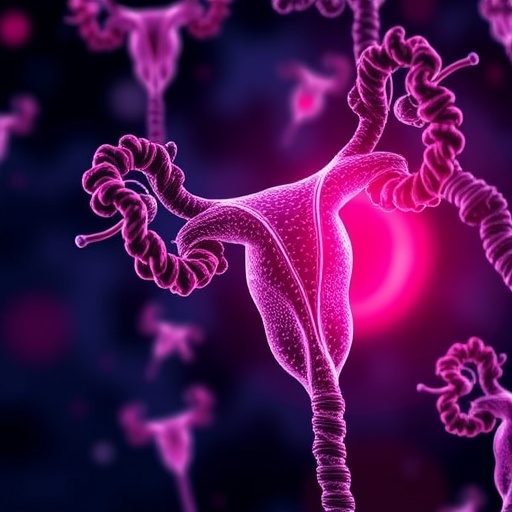In a groundbreaking study published in Nature Communications, researchers have unveiled a sophisticated multi-omic framework that challenges existing paradigms in the classification and treatment of hepatocellular carcinoma (HCC) among liver transplant recipients. This research not only redefines the biological understanding of HCC in patients extending beyond the traditional Milan criteria but also underscores the pivotal role of cancer-associated fibroblasts (CAFs) and stemness-related pathways in dictating tumor behavior and transplant outcomes. As liver transplantation remains the gold standard treatment for selected HCC patients, these insights have profound implications for precision medicine and transplant eligibility screening worldwide.
At the core of this transformative research lies the integration of multi-layered omics data encompassing genomics, transcriptomics, proteomics, and metabolomics, enabling a holistic picture of tumor heterogeneity. The team led by Ling, Yu, Zhan, and colleagues embarked on a meticulous investigation of HCC tumors harvested from liver transplant recipients whose tumors extend beyond the Milan criteria—a widely accepted benchmark that restricts transplant candidacy based on tumor size and number. By moving beyond this rigid framework, the researchers aimed to dissect molecular subtypes that escape conventional clinical detection but nevertheless influence patient prognosis and therapeutic response.
This study deftly captures the complexity of the tumor microenvironment by decoding the interactions between malignant hepatocytes and the surrounding stroma, particularly focusing on CAFs, the fibroblast populations known to modulate tumor progression and resistance. Their findings illuminate a critical axis of tumor-stroma crosstalk, where the activation status and phenotypic diversity of CAFs correlate strongly with the activation of stemness-related signaling cascades within cancer cells. This CAF-stemness nexus effectively stratifies patients into biologically distinct subgroups, challenging the simplistic morphologic criteria conventionally utilized.
Moreover, the researchers employed cutting-edge single-cell RNA sequencing combined with spatial transcriptomics to deconvolute the intricate cellular ecosystems within HCC tumors. This approach revealed spatially resolved heterogeneity wherein regions densely populated by CAFs were hotspots for stem-like tumor cells exhibiting elevated plasticity and proliferative capacity. These stemness characteristics are critical because they underpin tumor aggressiveness, metastatic potential, and treatment refractoriness, thereby shaping clinical trajectories post-transplant.
Notably, the multi-omic classification proposed by the authors diverges from prior molecular taxonomies by integrating the stromal compartment as a determinant of tumor identity rather than solely focusing on malignant cells. This paradigm shift has profound translational potential, suggesting that therapeutic strategies targeting CAFs or stemness pathways may synergistically improve outcomes in HCC patients deemed ineligible or at high risk under current Milan criteria frameworks.
Detailed proteogenomic analyses exposed novel signaling circuits underpinning the CAF-stemness-governed classification. For instance, pathways involving TGF-β, Wnt/β-catenin, and Notch signaling were found to be differentially activated among identified subgroups, with CAF-secreted factors acting as modulators of these stemness pathways. This molecular crosstalk orchestrates a dynamic microenvironmental feedback loop, perpetuating tumor cell dedifferentiation and survival under hostile conditions—a phenomenon that might explain the variable response rates to existing systemic therapies.
Additionally, metabolomic profiling uncovered distinct metabolic rewiring within tumoral subpopulations, particularly highlighting shifts toward glycolytic metabolism and amino acid biosynthesis in stemness-high tumors enriched with CAF interactions. These metabolic adaptations further support tumor growth under hypoxic and nutrient-deprived contexts typical of advanced HCC, providing additional therapeutic entry points.
From a clinical perspective, the study’s innovative classification system holds promise in refining transplant candidacy beyond the conventional Milan criteria. By embedding molecular signatures into decision algorithms, transplant centers may better identify patients who, despite exceeding size or numeric thresholds, possess less aggressive tumors with favorable stromal profiles, potentially expanding access to life-saving transplantation.
Importantly, this research also raises critical questions about post-transplant immunosurveillance and recurrence risk, as CAF-rich and stemness-enriched tumors could evade immune detection or foster an immunosuppressive niche. Integrating immunogenomic analyses into future studies may elucidate novel biomarkers for relapse prediction and personalized adjuvant therapies.
The technical rigor of the study was underpinned by application of robust bioinformatics pipelines and data integration frameworks capable of harmonizing disparate omics datasets. Such computational sophistication not only enhanced data interpretability but also set new standards for reproducibility and cross-study comparability in cancer systems biology.
Beyond its immediate impact on liver transplantation and HCC management, this work exemplifies the power of multi-omics to unravel tumor complexity and microenvironmental interplay, a theme increasingly critical across multiple cancer types. The paradigm of “stromal governance” over stemness pathways might extend to other solid tumors where fibroblast-tumor interactions dictate disease trajectory.
In essence, Ling and colleagues have provided a compelling narrative that melds molecular biology, clinical oncology, and computational sciences to redefine a crucial aspect of hepatocellular carcinoma management. Their CAF-stemness-governed classification offers a roadmap to personalized transplant strategies and novel therapeutic avenues, heralding an era where molecular precision replaces blunt clinical criteria.
As hepatocellular carcinoma continues to pose global health challenges, particularly due to underlying liver disease, viral hepatitis, and rising metabolic disorders, such integrative studies become indispensable. They not only facilitate patient stratification but also unravel the underpinning biological mechanisms driving heterogeneous treatment responses and outcomes.
Future research fueled by this landmark study might explore how the tumor microenvironment evolves temporally post-transplantation and under systemic therapies, employing longitudinal multi-omic profiling to capture dynamic shifts. Such insights could inform adaptive treatment strategies and post-transplant monitoring algorithms, moving closer to the ultimate goal of durable remission and improved survival.
In conclusion, this seminal multi-omic analysis transcends traditional classifications by spotlighting the essential role of cancer-associated fibroblasts and stemness regulation in hepatocellular carcinoma within liver transplant recipients exceeding Milan criteria. The team’s work not only challenges existing clinical dogma but also sets a fertile ground for developing molecularly guided, patient-specific therapeutic and transplant decisions, ushering in a new chapter in cancer precision medicine.
Subject of Research: Hepatocellular carcinoma (HCC) classification in liver transplant recipients beyond Milan criteria using multi-omic analysis focusing on cancer-associated fibroblasts (CAFs) and tumor stemness.
Article Title: Multi-omic analysis reveals a CAF-stemness-governed classification in HCC liver transplant recipients beyond the Milan criteria.
Article References:
Ling, S., Yu, J., Zhan, Q. et al. Multi-omic analysis reveals a CAF-stemness-governed classification in HCC liver transplant recipients beyond the Milan criteria. Nat Commun 16, 4392 (2025). https://doi.org/10.1038/s41467-025-59745-8
Image Credits: AI Generated
Tags: cancer-associated fibroblasts in liver cancerclassification of hepatocellular carcinomaliver transplantation and HCCmolecular subtypes of liver cancermulti-omics framework in hepatocellular carcinomaNature Communications hepatocellular carcinoma studyomics integration in cancer researchprecision medicine in cancer treatmentprognostic factors in liver cancerstemness-related pathways in tumorstransplant eligibility screening for HCCtumor heterogeneity in hepatocellular carcinoma





